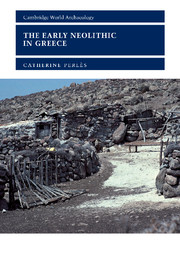Book contents
- Frontmatter
- Contents
- List of figures
- List of tables
- Acknowledgements
- Introduction
- 1 The land and its resources: the geographic context
- 2 The Mesolithic background
- 3 The introduction of farming: local processes, diffusion or colonization?
- 4 Foreign colonists: where from?
- 5 The earliest Neolithic deposits: ‘aceramic’, ‘pre-pottery’ or ‘ceramic’?
- 6 The spread of the Early Neolithic in Greece: chronological and geographical aspects
- 7 A case study in Early Neolithic settlement patterns: eastern Thessaly
- 8 Early Neolithic subsistence economy: the domestic and the wild
- 9 The Early Neolithic village
- 10 Craft specialization: the contrasting cases of chipped-stone tools, pottery and ornaments
- 11 A variety of daily crafts
- 12 Ritual interaction? The miniature world of ‘dolls or deities’
- 13 Interacting with the dead: from the disposal of the body to funerary rituals
- 14 Interactions among the living
- Conclusion
- Bibliography
- Index
14 - Interactions among the living
Published online by Cambridge University Press: 18 December 2009
- Frontmatter
- Contents
- List of figures
- List of tables
- Acknowledgements
- Introduction
- 1 The land and its resources: the geographic context
- 2 The Mesolithic background
- 3 The introduction of farming: local processes, diffusion or colonization?
- 4 Foreign colonists: where from?
- 5 The earliest Neolithic deposits: ‘aceramic’, ‘pre-pottery’ or ‘ceramic’?
- 6 The spread of the Early Neolithic in Greece: chronological and geographical aspects
- 7 A case study in Early Neolithic settlement patterns: eastern Thessaly
- 8 Early Neolithic subsistence economy: the domestic and the wild
- 9 The Early Neolithic village
- 10 Craft specialization: the contrasting cases of chipped-stone tools, pottery and ornaments
- 11 A variety of daily crafts
- 12 Ritual interaction? The miniature world of ‘dolls or deities’
- 13 Interacting with the dead: from the disposal of the body to funerary rituals
- 14 Interactions among the living
- Conclusion
- Bibliography
- Index
Summary
In the densely settled regions of northern Greece, interaction between individuals, families and groups was not only a necessity, but also an unavoidable consequence of settlement patterns. Interactions, willingly or unwillingly, peacefully or aggressively, were constantly taking place at many different levels: within the household, within the village community, with neighbouring communities or with more distant groups. ‘How to deal with others’, when ‘others’ were both numerous and variously related – or unrelated – to oneself, was probably the most difficult problem these early Neolithic societies had to solve. How and to what degree this universal problem was solved depends in large part on the social structures in general and, in particular, on the nature of the institutions developed to regulate conflicts.
Early Neolithic societies have long been considered ‘simple’, lacking status and role differentiation as well as hierarchical institutions. But some time ago Sherratt had already opposed Childe's vision of Neolithic societies as ‘simple’, arguing that the ability to organize large-scale exchanges without hierarchical control was, by itself, indicative of some form of complexity (Sherratt 1982: 15). There is indeed no sociological reason why a ‘complex’ society should necessarily be organized along hierarchical lines, even if hierarchy is a frequent outcome of socioeconomic differentiation. Early Neolithic Greece provides evidence for differentiated status, roles and functions, and for intense interaction at all levels of society.
- Type
- Chapter
- Information
- The Early Neolithic in GreeceThe First Farming Communities in Europe, pp. 283 - 298Publisher: Cambridge University PressPrint publication year: 2001



